Since Neolithic times, since at least 6000 B.C., the islands of the Aegean Sea and the lands bathed by it have been found to be inhabited. The political, economic, religious and artistic forms that developed until 2000 B.C. are given the name Cycladic civilization, since they had their main center in the Cyclades. The period between 2000 and 1400 B.C., on the other hand, takes the name Cretan or Minoan civilization, referring respectively to the Bronze Age island of Crete and the legendary figure of King Minos. Next, between 1400 and 1000 B.C., the Mycenaean civilization developed instead, named after the city of Mycenae, located in the Peloponnese.
At the center of the eastern Mediterranean, the Minoan civilization flourished, leaving behind impressive ruins, frescoes and symbols. Among the best-known images that have come down to us is that of young acrobats jumping on the back of a running bull. An act known as Minoan bullfighting. But what is it all about? Practiced since antiquity in the Mediterranean basin, bullfighting includes forms of combat involving cattle against each other, men against cattle or animals of other species. The earliest records date back to the second millennium B.C.E., with widespread use even in ancient Greece, particularly at ritual celebrations or public festivals. The term is also used today to refer to more recent forms of bull confrontation, such as Spanish bullfighting.
In any case, the bull in Minoan religion was a creature laden with meaning. Its figure appears insistently in artifacts found in the palaces of Knossos, Phaistos and Malia, in the form of sculptures, frescoes, seals or reliefs. The Cornadella Consecration, recurring architectural elements in the stylized form of taurine horns, adorned roofs, altars, larnakes, terracotta coffins, and palace walls, signaling the sacredness of the spaces. First identified by Sir Arthur Evans (Nash Mills, 1851 - Youlbury, 1941), the British archaeologist who unearthed the palace at Knossos in the early twentieth century, clay or stone structures also appeared in the mountain shrines and major ceremonial sites of Minoan Crete.
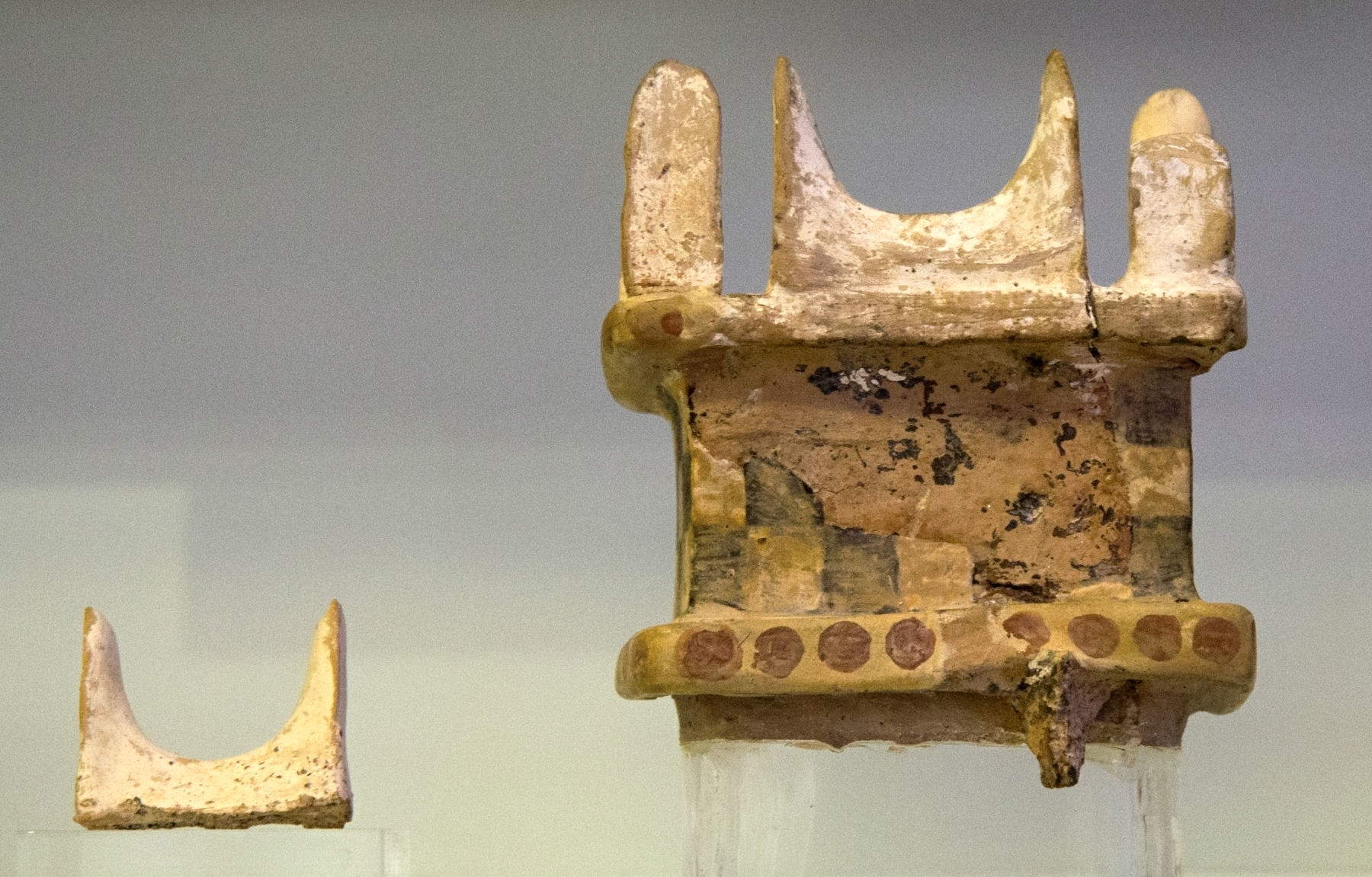
Although often associated with bull worship, sacred horns seem to have held multiple meanings: their orientation, connections to sunlight, and their presence at symbolically relevant points in architecture also indicate links to the sun, the sky, and cyclical regeneration. Some of the best-known sites where they have been found include the south entrance to the palace at Knossos, where a large pair of horns is still visible; the palatial complex at Archanes, where these figures were integrated into religious ceremonies; and the archaeological site of Nirou Megaron, which features a stepped base topped with sacred horns, indicating well-structured ritual use.
Some scholars, such as Emilia Banou, advance hypotheses that trace the Consecration Horns back to solar symbolism. In particular, they point to formal affinity with certain Egyptian ideograms, such as those for “mountain” and “horizon,” associated with the solar god Ra. Minoan horns, in this context, could have served as devices for celestial observation, framing precise astronomical alignments or accompanying rituals related to the solar cycle and the renewal of fertility. In some votive depictions, a goddess with raised arms appears juxtaposed with horns, suggesting a female cult connected to divine light, rebirth and cosmic order.
Their use continued even after the decline of the palatial civilization, attesting to a symbolic and religious continuity. There is no shortage of related depictions: frescoes and seals with scenes of sacred bulls, rituals and sacrifices; bucrania, sacrificed bull heads, arranged in shrines; or depictions of the double axe set between two horns, an emblem of power and sacredness. Some interpretations see the horns as a direct reference to the bucranium, a symbol of sacrifice, while others speculate that the larger structures served as symbolic thrones for deities or rulers. There are also smaller horn-shaped artifacts that may have had a practical function, such as hearth supports or votive containers. The breadth of contexts and variations thus suggests that the Consecration Horns met multiple needs, both cultic and functional.
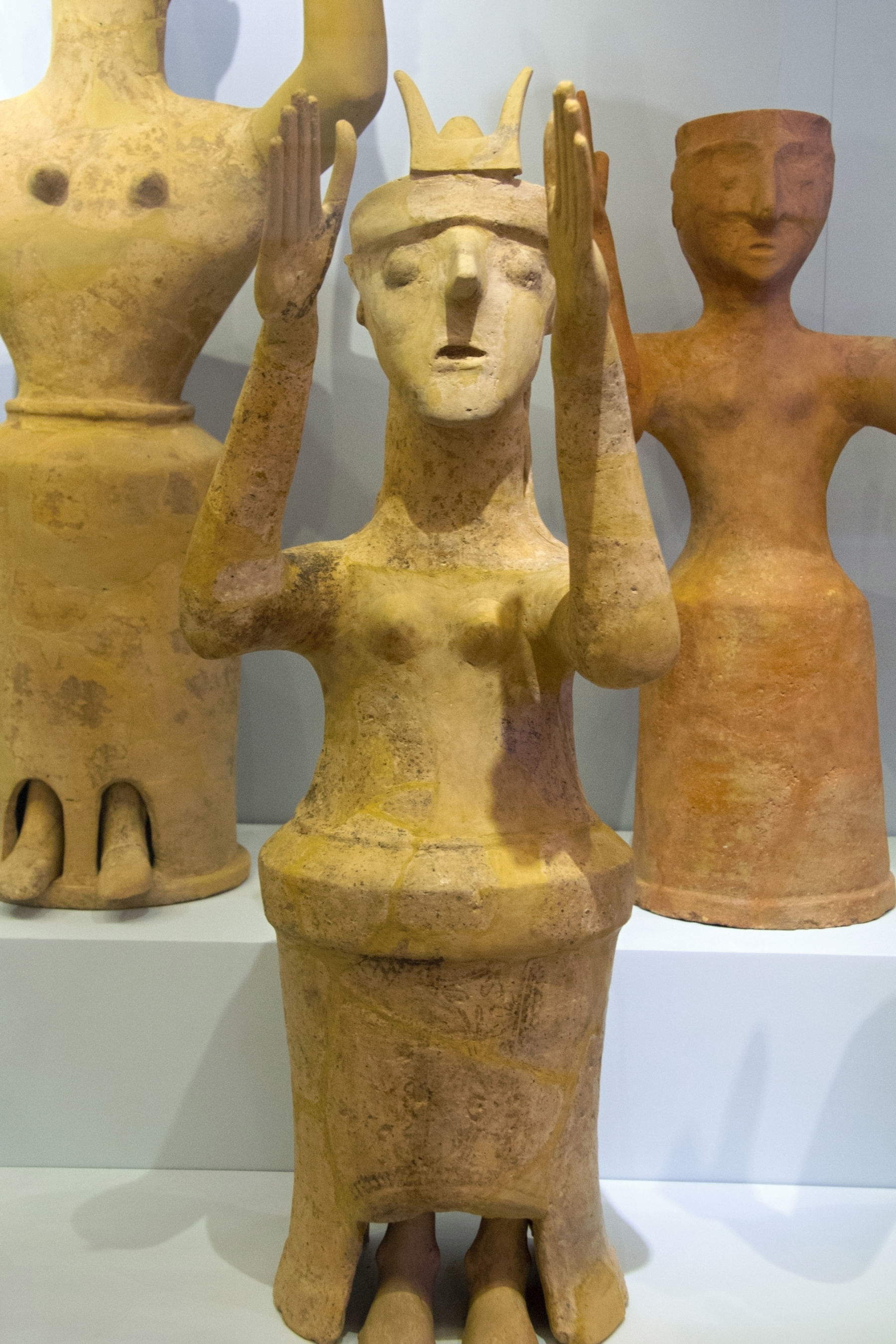
Within the Minoan-Mycenaean civilization, the bull is present in multiple artistic representations including frescoes (the best known of which is in the palace of Knossos), bas-reliefs and seals. And in many of the reproductions, the ceremonial practice known as taurocatapsia or bull jumping is documented, during which a priest or acrobat would confront a running bull, grab it frontally by the horns and, taking advantage of the animal’s momentum, perform an acrobatic leap over its back. According to some speculations, the animal could later be sacrificed, but never injured or killed during the performance. This suggests that it was a ritual or sports performance and not a fight.
According to Sir Arthur Evans, bullfighting would have been part of the religious cult centered on the bull. The Minotaur myth itself, elaborated later in Greek culture, retains echoes of the rites, transfiguring them into the mythical tale of a half-man, half-bull monster imprisoned in the Labyrinth.
In the essay Bronze Age Representations of Aegean Bull-Games, III published in 1995 for the University of Liege, John Younger instead proposes a nuanced reading: bullfighting would also have been a form of public spectacle, with social and political functions. Indeed, Younger notes that the arrangement of frescoes and arenas in Minoan palaces suggests the presence of spectators and thus a collective performative dimension.
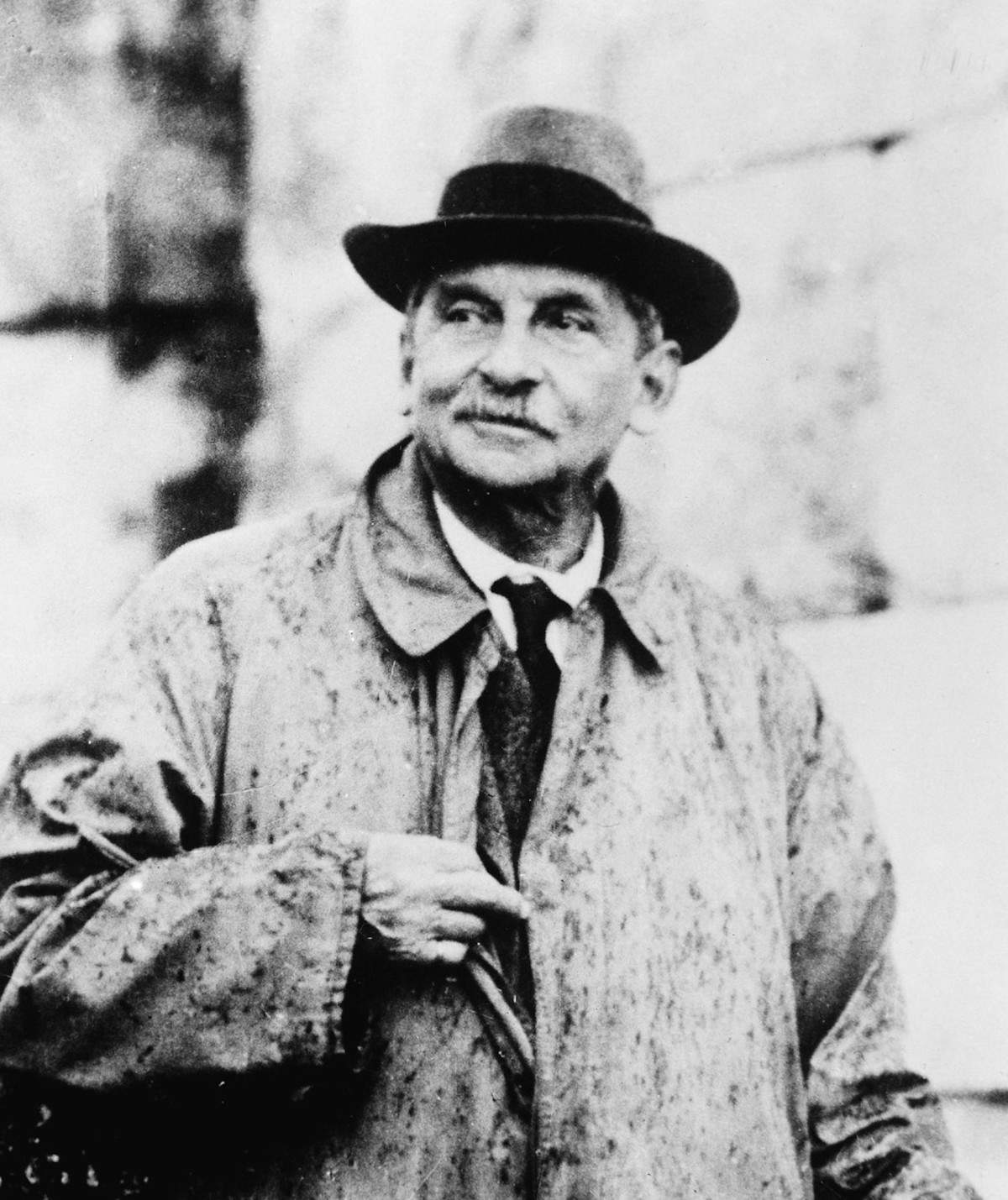
But it is only through images that the world of bullfighting takes shape: frescoes, vases, gold and ivory plates preserve with extreme rigor the poses of the athletes, the muscular tension of the bull, the precise choreography of the jump. That of the Bullfight is a grammar that is repeated over the centuries, with slight variations, demonstrating the centrality of bull-leaping, the jumping on the back of the bull.
And this is where one of the best-known images of Minoan art comes to our aid: theTaurocatapsia Fresco, preserved in the Archaeological Museum in Heraklion, Crete. In fact, Younger identifies three main iconographic modes through which art represents gestures in the work. The first, perhaps the earliest, shows the athlete grabbing onto the animal’s horns to be lifted up and then flying past. It is a dynamic, but rare sequence, found only in early Late Minoan examples. More widespread, and almost codified, is, on the other hand, the so-called diver’s pattern: the athlete starts from an elevated height, throws himself forward with his hands toward the bull’s neck, and after a perfect flip lands behind the animal. In this case, the body posture is repeated with such regularity as to suggest the existence of precise rules in the performance, if not in the event itself.
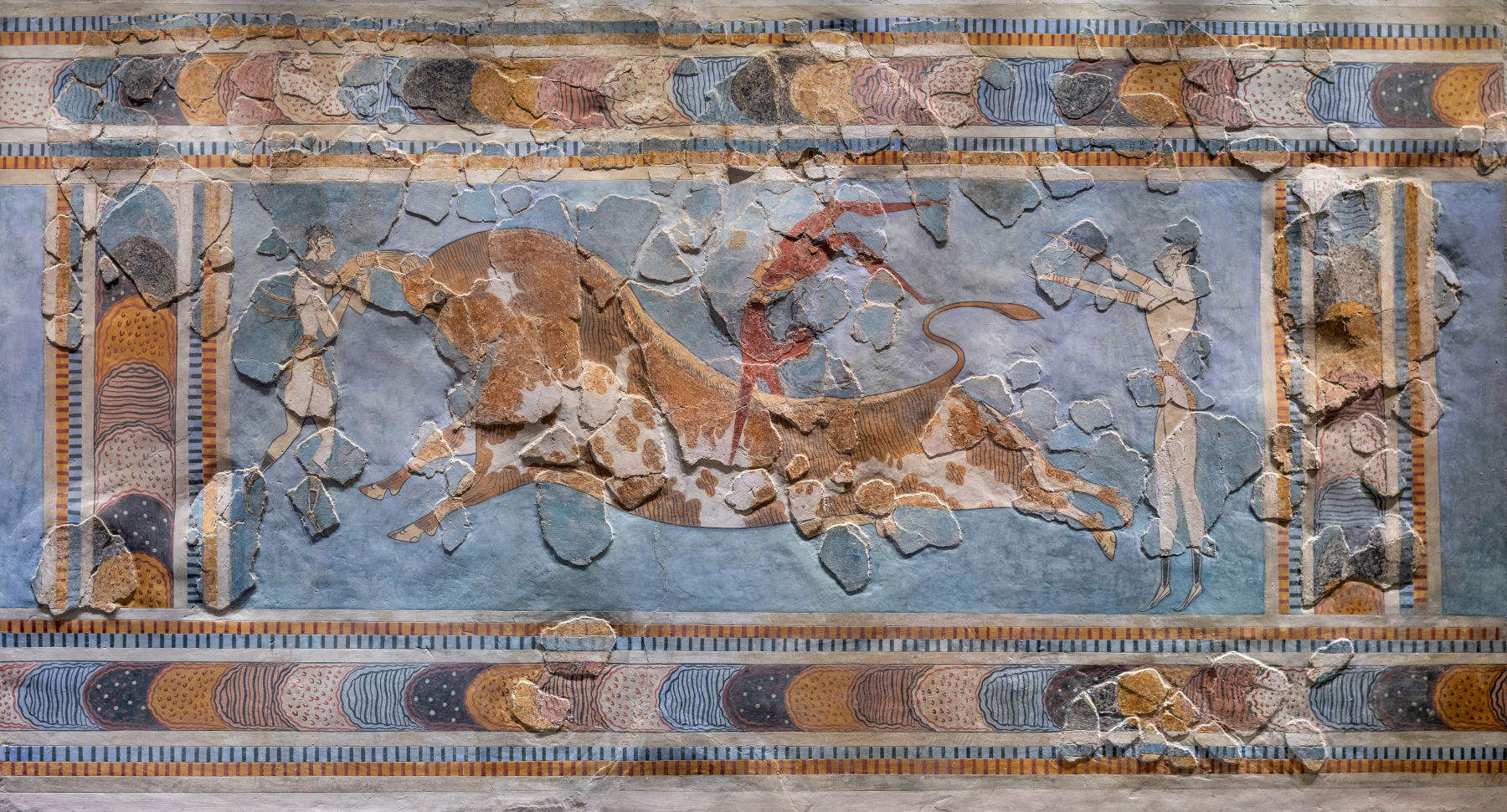
The third pattern, perhaps the most enigmatic, is that of the leaper suspended in midair: a horizontal human figure, with one hand on the nape of the bull’s neck and the other on the horn, as if in an eternally still instant. The floating leap, present especially in the seals, evokes less an actual gesture than an idea: that of dominance, of balance between animal power and human control.
In ancient Rome, on the other hand, the encounter between man and bull took many forms, from physical competition in public games to symbolic sacrifice in religious cults. Initially, the spectacles depended on the domesticated nature of the cattle, bred to run and not to charge. In ritual, the animal became the protagonist of performances with powerful symbolic value. Such is the case with tauroctonia, a central element of Greco-Roman Mithraic religion, in which the deity Mithras, called tauroctonos (slayer of the bull), was depicted in the solemn act of sacrificing a bull. The image, always the same in pattern, occupied the centerpiece of each Mithraeum, an underground place designated for initiatory worship. Alongside this, another rite, the taurobolion, involved the actual sacrifice of a bull as part of veneration to the Great Mother, with purifying and regenerative purposes.
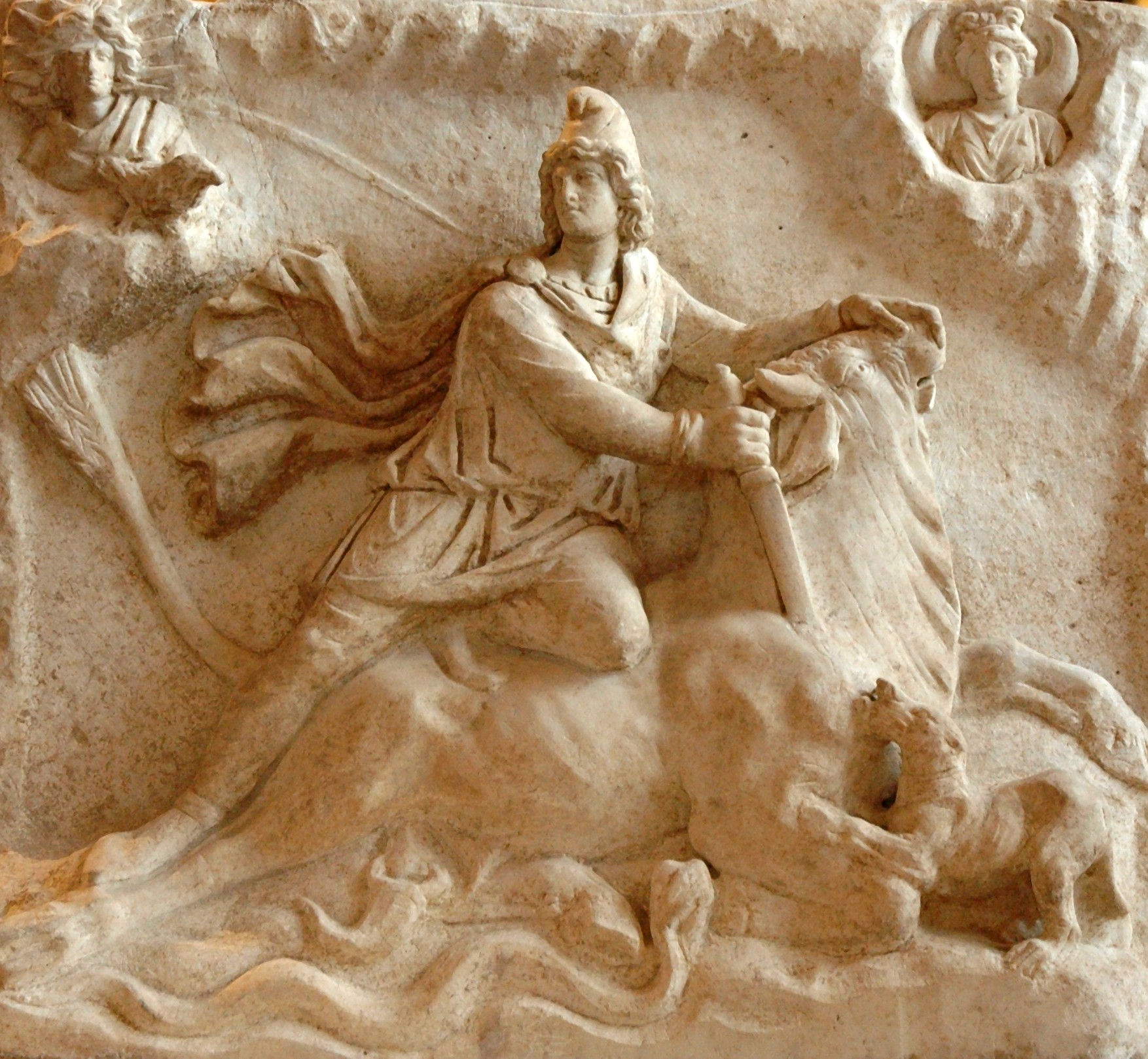
Quite different, but parallel in the centrality of the animal, was the Iberian tradition. Before the Punic Wars, the Celtiberian peoples were well aware of the wild nature of their livestock. They turned the hunt into a game, and the game into military strategy: during the Carthaginian siege of 228 B.C., the inhabitants of one city defended themselves by throwing a herd of wild bulls at the enemy, whose horns had been slinged with resinous wood and burning flashlights. The herd devastated the Carthaginian lines, and in the confusion Hamilcar Barca himself, Hannibal’s father, fell.
The Moors resumed this practice by tying burning torches to the tails of the bulls to turn them into mobile weapons. And even in peacetime, the figure of the bull remained central. Tales speak of men who, armed with axes or spears, publicly challenged the animal, demonstrating courage and dexterity through the use of skins or capes, tools that anticipate the modern capote.
The long Visigothic rule shaped a new form of entertainment: a direct, almost brutal confrontation between human and animal strength. The Muslims, on the other hand, introduced a clear separation of roles: the nobles on horseback performed the decisive maneuvers, while assistants on the ground controlled the bulls. Out of this tradition grew bull-slaying tournaments, which were held in city plazas or open spaces just outside urban centers, the same plazas that would give their name to bullfighting arenas. As early as the late 11th century, the games had become a stable part of the festive calendar. The best known survival is Pamplona’s Fiesta de San Fermín, where each year the running of the bulls returns to the streets a ritual rooted in myth, war, and religion.
Warning: the translation into English of the original Italian article was created using automatic tools. We undertake to review all articles, but we do not guarantee the total absence of inaccuracies in the translation due to the program. You can find the original by clicking on the ITA button. If you find any mistake,please contact us.